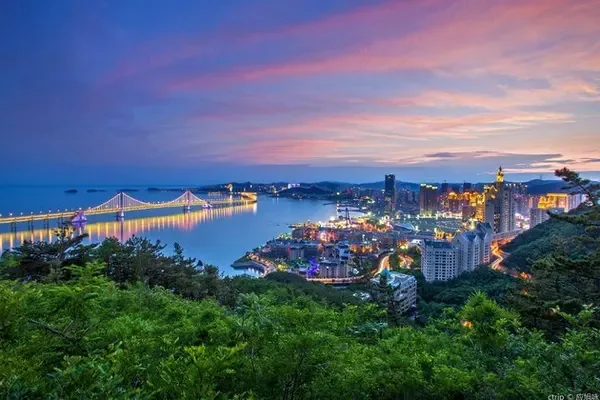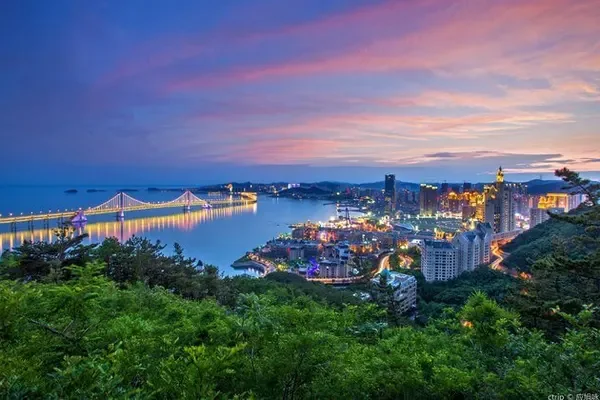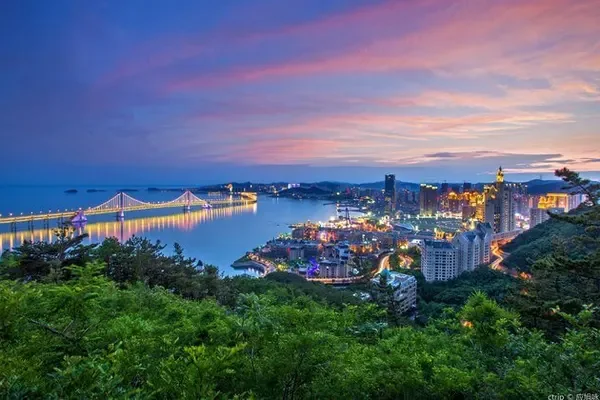
Beijing, now the capital of the People's Republic of China, is also an ancient capital with a history of more than 3,000 years.
The central axis of Beijing refers to the axis of symmetry of the east-west symmetrical layout of buildings in Beijing since the Yuan Dynasty. The central axis of Beijing in the Ming and Qing Dynasties started from Yongding Gate in the south and ended at the Bell and Drum Tower in the north.
In the 1990s, in order to connect the city center and the Asian Games Village in Beijing, the Zhonggulou Bridge on the Second Ring Road led to Gulouwai Street, and it was renamed Beichen Road after going north to the Third Ring Road. This road became an extension of Beijing's central axis.
There are many ancient streets located on the central axis of Beijing, and there are countless places worth visiting now.
This trip to Beijing, due to time constraints, only night tour of the Financial Street in Xicheng District, wandering around Beigong Forest Park, walking Jingshan Park, Nanluoguxiang and so on.


Financial Street is located in Xicheng District, which is currently the financial center of Beijing and even China. This area brings together the People's Bank of China, China Banking and Insurance Regulatory Commission, China Securities Regulatory Commission and other financial regulatory departments, as well as many large domestic and foreign financial institutions and state-owned enterprise headquarters. It is capital, technology and knowledge-intensive. It is one of the areas with the highest income and the fastest tax growth, and it is also the area with the most concentrated high-end industries and the greatest value creation in Beijing and even the whole country.

On the quiet streets at night, it is impossible to appreciate what kind of financial reform is being planned in these buildings.

Mr. Lao She once said that you must live in Beiping in autumn, and autumn in Beiping is heaven.
In the golden autumn of Beijing, seeing the red leaves is something that every tourist will definitely check in. Beigong Forest Park is located in the northwestern mountainous area of Fengtai District, Beijing, 20 kilometers away from the center of Beijing. It is a hilly natural scenic spot. There are cultural landscapes such as pavilions, corridors, pavilions, and towers in the park, as well as natural scenic spots such as Fangze River, Xiaojiangnan, Fenglin Road, and Hualingou. Beigong in late autumn is so beautiful.





The main colors in the park are mostly red leaves with maple leaves and yellow leaves with ginkgo. The area of the scenic spot is very large, and there is no bus in the park, so you need to walk.


The small Jiangnan Park in the park is quite distinctive.

















The "Nine Creeks and Emerald Greens" in the Beigong imitate the Nine Streams of the West Lake, creating a quiet place of "other world" in the park forest, hoping to forget the fatigue for a moment, forget the eastward flow of water, and the westward direction of the sun.




Of course, with such a dedicated spirit, how can there be no scenery that will never be forgotten.

The next day, Didi took a taxi to Jingshan Park, walked the whole journey, and took a slow tour of Jingshan Park and Tongluogu Lane.

Beijing Jingshan Park is a beautiful and unique royal garden. As early as the Jin Dynasty, soil was piled up to form hills. In the Yuan Dynasty, it was established as a royal forbidden garden and named Qingshan. During the Yongle period of the Ming Dynasty, the soil dug from the moat and the dregs from the demolition of the southward city wall were piled up here to form a tall mountain named Qingshan. Long Live Mountain. In the twelfth year of Shunzhi in the Qing Dynasty (1655), the mountain was renamed Jingshan, and a large-scale expansion was carried out during the Qianlong period (1749-1751).

It is said that the Forbidden City is a treasure land of geomantic omen, which originates from the fact that the Forbidden City is surrounded by mountains and rivers. The mountain is said to be Jingshan, and the water should be the North Sea. Jingshan is the imperial garden of the Yuan, Ming and Qing Dynasties. It is located on the central axis of Beijing. When you climb the highest Wanchun Pavilion, you can see the Shenwumen (North Gate) of the Forbidden City across the street to the south; the Bell and Drum Tower to the north, and the Beihai, TV Tower; in the east, you can see the China Zun, the tallest building in Beijing.

The place where Emperor Chongzhen of the Ming Dynasty hanged himself, but this tree is no longer the tree where Chongzhen hanged himself.

There are Guanmiao Pavilion, Zhoushang Pavilion, Wanchun Pavilion, Jifang Pavilion and Fulan Pavilion built on the mountain, and Wanchun Pavilion is the highest point.



Wanchun Pavilion is located on the central axis, looking south to the Forbidden City, it is really magnificent.

To the west, look at Yong'an Temple and the White Pagoda.

To the north is the Shouhuang Hall.



Strolling north along the central axis of Jingshan Park is the Bell and Drum Tower, next to Yandai Xiejie.







To the west is Shichahai.



As the time reporting center of the capitals of the Yuan, Ming, and Qing dynasties, the Bell and Drum Tower has a long history of "beating the drum at dawn to wake people up, and ringing the bell at night to wake them up".






From the central axis south to north to the Bell and Drum Tower, then go east along Gulou East Street to the north end of Nanluoguxiang. Nanluoguxiang runs north-south and is about 800 meters long. Eight hutongs are neatly arranged in the east and west. From south to north, the 8 hutongs in the west are Fuxiang Hutong, Maoyi Hutong, Yuer Hutong, Maoer Hutong, and Jingyang Hutong. Hutong, Shajing Hutong, Heizhima Hutong, Qiangulouyuan Hutong; the 8 alleys in the east are Chaodou Hutong, Banchang Hutong, Dongmianhua Hutong, Beibingmasi Hutong, Qinlao Hutong, Qianyuanensi Hutong, Houyuanensi Hutong , Ju'er Hutong. The whole block is like a big centipede, so it is also called Centipede Street.



Hutongs and Lifang are the basic organization of ancient residential areas, which are equivalent to modern communities and streets. Since the Ming and Qing Dynasties, this area has always been a "rich area". Many dignitaries and celebrities have lived here, from the generals of the Ming Dynasty to the princes of the Qing Dynasty, from the president of the Beiyang Government to the president of the Kuomintang, from the masters of literature to the masters of the painting world. The hutongs have left rich historical traces, each hutong has a rich cultural heritage, and each house tells the old story of the royal palace. In ancient times, Beijing had the title of "rich in the east and rich in the west, poor in the south and humble in the north", but today's Beijing is an international metropolis, and the development of the north-south direction is better than the east-west direction.


Beijing Siheyuan was built on a large scale after the establishment of the capital of Beijing in the Ming Dynasty. Houses are built around a courtyard, with four-height courtyards in the southeast and northwest. Many courtyard houses form a residential area, and the residential areas are separated by hutongs. As for the north, it is called the meridian, and from the east to the west, it is called the latitude. The main street is 24 steps wide, 384 fire lanes, and 29 streets. Build 3 to 4 small courtyards to form a courtyard. Generally, the regular courtyard houses are located in east-west hutongs and face south. The basic form is the north room (principal room), the south room, and the east and west wing rooms, which are surrounded by high walls to form a quadrangle with a door. The gate is opened in the southeast corner of the house. The total number of rooms is generally 5 rooms in the north room, 3 main rooms, 2 ears, 3 rooms in the east room and 3 rooms in the west room, and 4 rooms in the south room, including the gate hole and the hanging flower door.

The door hairpin is a wooden decorative component on the gate of the courtyard gate, and at the same time plays the role of strengthening the door frame. The front face is embossed with flowers, peonies and gourds to show the meaning of wealth and honor. However, most of the engraved characters are carved with a character on each of the four door hairpins facing each other, such as "Hui Wo Di Ji", which means to lead me to an auspicious place. It is also a sign of status, there are two for common people's homes, four for big houses, and up to 12 for royal and royal residences.

The depth of the gate depends on the wealth of the family. "The princes and grandsons follow in the footsteps, and the green pearls weep and drop the scarves. Once the Hou family enters as deep as the sea, Xiao Lang is a passerby from then on." It is a good description. The vertical flower gate is the dividing line between the inner and outer courts. "The gate does not go out, and the second gate does not pass." The "second gate" here is the vertical flower gate. Generally, there is a wall called a screen wall inside or outside the gate, which is also an important place to show the status, taste and financial resources of the owner. The most luxurious screen wall existing today may be the Nine Dragon Wall in the Ningshou Palace in the Forbidden City.




In a strictly hierarchical feudal society, the structure of the courtyard house, especially the gate, directly represented the rank and social status of the owner. This is what is meant by the so-called "equal family status" and "equal family status". Therefore, people attach great importance to the type and grade of the gate. Even the door studs, door frames, door panels, door hairpins, animal faces, and horse boards are all very particular.

It is said that this is the former residence of Feng Guozhang, with the Dismounting Stone on the left and the Mounting Stone on the right. It is strongly recommended to stand on the Shangma Stone when taking pictures in front of the door, which means upward.


There are so many delicacies in old Beijing, among which Peking duck is the most well-known.




